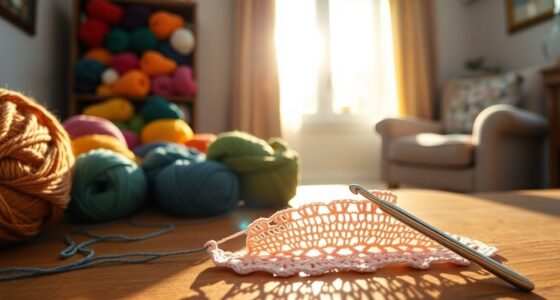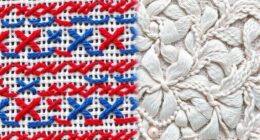To add a professional touch to your blankets and more, mastering crochet edging techniques is essential. You can create beautiful borders using lace patterns, scallops, picots, or intricate openwork designs to enhance your project’s appearance. Focus on consistent tension and pattern details to achieve a polished finish. Whether you want subtle accents or bold statement borders, perfecting these skills elevates your craftsmanship. Keep exploring, and you’ll discover even more ways to customize and refine your crochet edges.
Key Takeaways
- Use lace patterns and openwork stitches to add elegant, decorative edging to blankets and other projects.
- Incorporate scalloped or picot borders for a refined, textured finish.
- Maintain consistent tension and stitch uniformity for a polished, professional look.
- Practice on scrap pieces to master techniques before applying to your final project.
- Combine different stitch styles and yarn choices to customize and enhance your project’s final appearance.

Crochet edging techniques can transform simple projects into polished, professional-looking pieces. Whether you’re finishing a blanket, a pillow, or a scarf, adding a well-crafted border elevates the overall appearance and gives your creation a refined touch. One of the most popular ways to achieve this is through lace patterns, which add delicate, intricate detail to your work. Lace patterns involve open, airy stitches that create a textured, decorative effect. They’re perfect for adding elegance and sophistication, especially when used as decorative borders. When you choose to incorporate lace patterns into your edging, you’re not just finishing the project—you’re turning it into a true work of art. These patterns can be simple or complex, depending on your skill level, but they always lend a sense of grace and finesse to your piece.
Using decorative borders is another effective technique to enhance your crochet projects. These borders serve as framing elements that define the edges and can incorporate various stitch styles to suit your design. For example, a scalloped border made with shell stitches creates a soft, rounded edge, while a picot border adds tiny loops that give a delicate, lacy finish. You can also combine different stitches within your border to create unique textures and visual interest. Decorative borders are versatile; they can be subtle accents or bold statements, depending on your choice of yarn and stitch pattern. When working on blankets, adding a decorative border not only beautifies the piece but also helps reinforce the edges, preventing fraying over time. For other projects like pillows or table runners, borders frame the main fabric, making the entire piece look complete and professionally finished.
To master these edging techniques, you need to pay attention to your tension and stitch consistency. For lace patterns, it’s essential to keep your stitches even and to follow the pattern carefully, especially when working with openwork designs. When adding decorative borders, choose a stitch pattern that complements your project’s overall style and scale. Practice on scrap pieces if needed to perfect your technique before working on your final project. Remember, the key to beautiful crochet edges is patience and precision. With a little practice, you’ll be able to create stunning lace patterns and decorative borders that showcase your skills and add a professional touch to everything you make. The effort you put into perfecting these techniques will shine through in the finished product, making your handmade items truly stand out.
Frequently Asked Questions
Can Crochet Edging Be Added to Already Finished Blankets?
Yes, you can add crochet edging to already finished blankets. If you’re reusing old blankets or want to give a fresh look, adding edging after completion is a great idea. Simply clean the blanket, choose your preferred edging style, and then carefully attach the new crochet border along the edges. This method allows you to personalize your blanket and give it a polished, finished appearance without starting from scratch.
Which Yarn Types Work Best for Crochet Edging?
In a flash, you realize the best yarns for crochet edging are natural fibers like cotton and wool, which provide softness and durability. Synthetic fibers, such as acrylic, also work well, especially for washable, budget-friendly options. Both types hold shape nicely and offer various textures. Choose based on your project’s feel and care needs. Natural fibers lend a classic touch, while synthetic fibers give you versatility and easy maintenance.
How Do I Choose the Right Edging Pattern for Different Projects?
You should choose an edging pattern that matches your project’s overall style and purpose. Consider matching patterns to the texture, complexity, and scale of your project—simple stitches work best for delicate or intricate designs, while bold patterns suit larger pieces. Think about project suitability, like using scallops on blankets for a soft look or a sleek edge for modern decor. Always pick a pattern that enhances your project’s final appearance and feel.
Are There Eco-Friendly or Sustainable Yarn Options for Edging?
Yes, you can choose eco-friendly edging options by looking for biodegradable fibers like hemp, bamboo, or organic cotton. Recycled yarn options, made from plastic bottles or other post-consumer materials, are also great sustainable choices. These materials reduce waste and environmental impact, giving your projects a greener touch. Always check labels and supplier info to guarantee you’re selecting truly sustainable options for your crochet edging.
How Can I Prevent Edging From Stretching or Warping Over Time?
Think of your edging as a delicate tightrope walker; it needs balance to stay steady. To prevent stretching and warping, use lightweight, stable yarns and choose appropriate stitch patterns. Incorporate even tension while working, and avoid pulling too tight. Finishing with a gentle blocking process helps set the shape, boosting warping resistance. Regularly handle your project carefully to maintain its neat, resilient edge over time.
Conclusion
Now that you’ve mastered these crochet edging techniques, your blankets will transform from simple to spectacular overnight—like magic, but better! Every stitch you add is a tiny masterpiece, turning your project into a showstopper that’ll impress everyone and last forever. So go ahead, grab your hook, and give your creations that perfect finishing touch. With these skills, your crochet work will shine brighter than the stars, making every blanket a true work of art!









